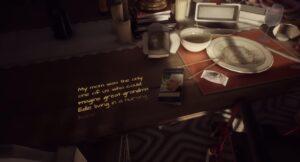I decided to do this critical play on the game” What Remains of Edith Finch” and it was a delightful experience discovering how such a great and rich story can be told through incredibly simple mechanics. At first glance of this week’s theme, I was skeptical that walking would be sufficient enough in building out an entire world and telling its intricately woven stories; I was just unbelieving that this type of gameplay would be at all entertaining for players in a game market so saturated with creative puzzles and stimulating gameplay actions. “What Remains of Edith Finch” provided a great gateway into this style of gameplay for me through its incredible use of immersive narration, detail and simple interactions that worked in conjunction to tell the strange occurrences within the Finch family.
This is how the game follows: playing as Edith, the player will venture throughout the colossal, and mystery infested Finch house, delving into its depths to uncover that tale that unveil her family’s legacy and unraveling the secret behind her solitary existence as the last surviving member. Each narrative discovered allows the player to inhabit the final moments of a different family member, spanning generations (like Edith’s great great grandfather) from the distant past to the present day.
The game is a narrative-focused adventure game and uses simple mechanics, like walking, to expel any unnecessary distractions when uncovering its story, thus excelling at creating interactivity. While walking can often be overseen as a boring mechanic, its simplicity allows the game to be filled to the brim with details about each encountered tale whereas other games with more complex games couldn’t do that without overwhelming its players. Additionally, its simplicity also slows down the game so that the player has time and freedom to interact with all other details that were painstakingly put into the game. As players are traversing through a semi-linear series of rooms, footpaths, crawlspaces, and secret passages, in the ancestral house and out in the surrounding wilderness, Edith narrates, guiding the player and providing commentary on her own thoughts, experiences, and relations to each of her family members. There are various narrative-related objects such as books, clutter, and decorations that provide Edith this opportunity to speak with the player. Walking allows the player to take their time to find many of these objects and tie in all the environmental details with Edith’s narration. And it’s often in these interactions with memory-laced objects that the character associated with that object will narrate instead. For example, when going through Barbara’s room, the comic that Eddie keeps telling Barbara’s death by monsters is narrated by a monstrous voice. Not only does this allow the player to feel more immersed into the story (not just understanding it), the player is also introduced to an unreliable narrator that they need to learn to dissect throughout the game.
Walking tells the story slowly and deliberately, focusing on delivering the narrative of the game without any distractions. In this way, it builds the atmosphere and the interaction of the game as players then stay in the game longer; unless the genre’s horror, this provides a meditative narrative experience where nothing matters other than hearing a good story, entering its world, and being on that journey as that character.






